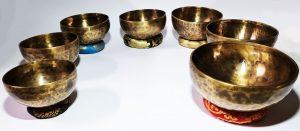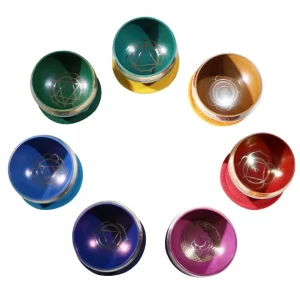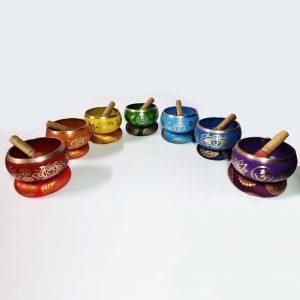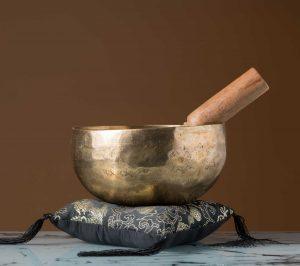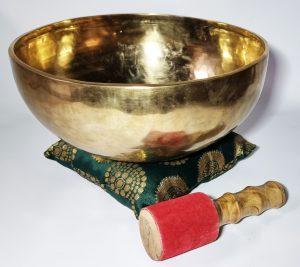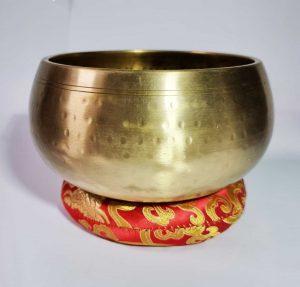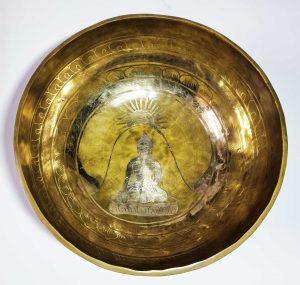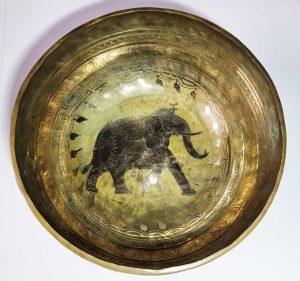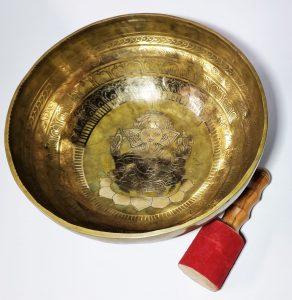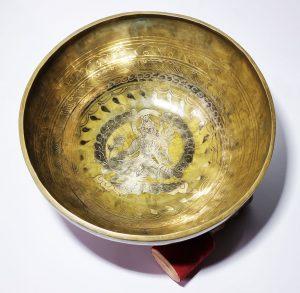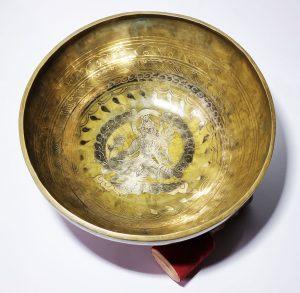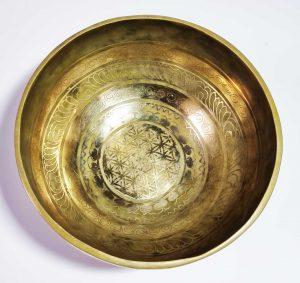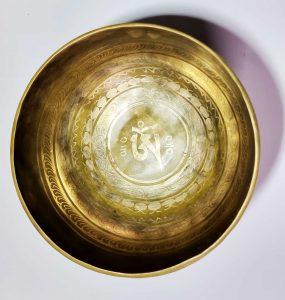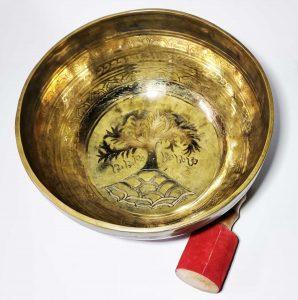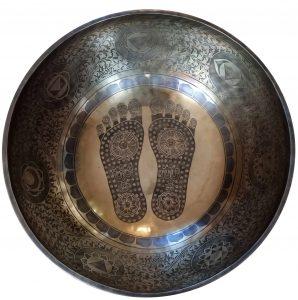
Tibetan singing bowls, sometimes referred to as Himalayan bowls, are a type of standing bell that, rather than being hung or held aloft, is set on a surface to play. Here’s a rundown of their features, uses, and significance:
- Origin and History: Although commonly referred to as “Tibetan”, these singing bowls are found throughout the Himalayan regions, including Nepal, Bhutan, India, and Tibet. Their origins are somewhat mysterious, but they are believed to have been used for many centuries, perhaps even millennia.
- Material and Construction: Traditionally, these bowls were made from a blend of seven metals, which are said to correspond with the seven celestial bodies – gold (Sun), silver (Moon), copper (Venus), iron (Mars), mercury (Mercury), tin (Jupiter), and lead (Saturn). However, not all bowls have this mix, and many contemporary bowls might be made from fewer metals.
- Use: By striking the bowl with a mallet or running the mallet around the bowl’s rim, one can produce a sustained musical note. The sounds and vibrations generated are believed to have healing properties and are used in meditation, music, relaxation, and personal well-being practices.
- Therapeutic and Meditation Benefits: Many people claim that the harmonics produced by the bowls can promote deep relaxation, reduce stress, and aid in meditation. Some even claim that they have healing properties, although scientific evidence is still limited on this front.
- Chakra Balancing: In some spiritual and therapeutic practices, different bowls are said to correspond to different chakras (energy centers in the body). Playing a particular bowl can help balance or realign that specific chakra.
- Modern Use: Today, Tibetan singing bowls have gained popularity worldwide. They’re not just restricted to spiritual or religious contexts but are also used in alternative therapies, music therapy, performance, and relaxation practices.
- Varieties: There are various types of bowls, each with a unique sound profile, based on size, shape, material, and age. Antique bowls, often cherished for their sound quality and historical significance, can fetch a high price in the market.
If you’re considering purchasing a Tibetan singing bowl, it’s essential to try it out personally or listen to a recording, as each bowl is unique and might resonate differently with each individual.

Tibetan singing bowls have been used for centuries in healing and meditation practices. Various benefits, both anecdotal and researched, are attributed to the use of these bowls. Here are some of the commonly reported benefits:
Deep Relaxation
The harmonic tones emitted by the bowls can induce a state of deep relaxation. As you focus on the sound, your breathing and heart rate can slow down, leading to a relaxed state.
Stress and Anxiety Reduction
Listening to the resonating sound of the bowls can distract the mind from anxieties and stressors, providing a moment of calm and peace. Some people liken the experience to a sonic massage or a brief escape from daily worries.
Enhanced Meditation
Many people find that the sounds from the bowls aid in deepening their meditation practices, helping to keep the mind focused and preventing it from wandering.

Chakra Balancing
In some spiritual traditions, it’s believed that Tibetan singing bowls can help balance and align the chakras, or the energy centers of the body.
Stimulation of the Immune System
There’s a belief that the vibrations from the bowls can stimulate the body in specific ways that may help boost the immune system. The idea is that sound frequencies can have an impact on the body’s energy balance, though more scientific research is needed to validate this claim.
Promotion of Normal Sleep Patterns
Because of their relaxation and stress-reducing effects, some people use singing bowls as a tool to combat insomnia and promote better sleep.
Enhanced Mindfulness and Awareness
Because of their relaxation and stress-reducing effects, some people use singing bowls as a tool to combat insomnia and promote better sleep.
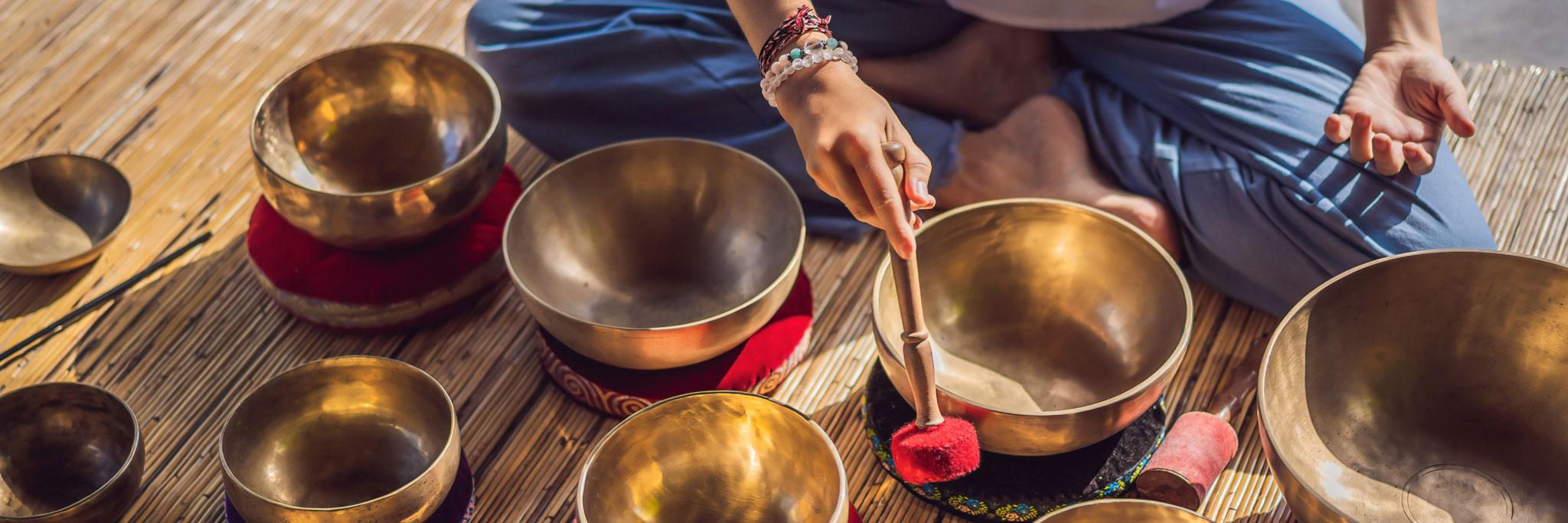
Emotional Release
Some users report emotional releases or breakthroughs during sessions with Tibetan singing bowls. The calming sounds can provide a safe space for confronting and processing difficult emotions.
Pain Relief
Some anecdotal reports suggest that the bowls’ vibrations can help alleviate certain types of physical pain. While there isn’t robust scientific evidence to support this, the relaxation and stress-reducing qualities of the bowls might indirectly contribute to pain relief for some individuals.
Improvement in Circulation and Blood Flow
The deep relaxation promoted by the bowls can lead to vasodilation, an expansion of blood vessels, which might improve circulation.
While many swear by the therapeutic effects of Tibetan singing bowls, it’s essential to approach their use with an open mind and not expect them to replace traditional medical treatments. For those with specific medical or psychological concerns, it’s crucial to consult with professionals and use singing bowls as a complementary therapy.


